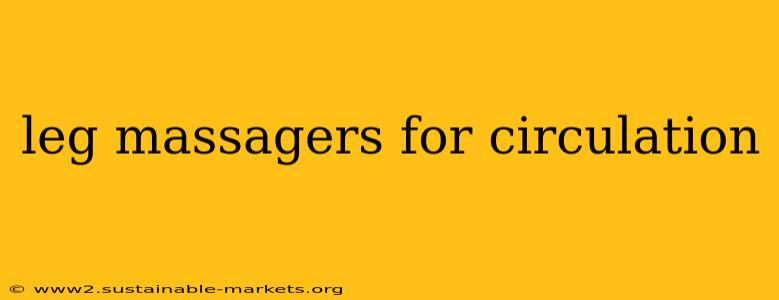Poor circulation in the legs can lead to discomfort, pain, and even more serious health issues. Fortunately, leg massagers offer a convenient and often effective way to stimulate blood flow and alleviate many of these problems. This comprehensive guide will explore the benefits, types, features to consider, and potential drawbacks of leg massagers for improved circulation.
Understanding the Benefits of Leg Massagers for Circulation
Leg massagers work by applying pressure and movement to the legs, encouraging venous return and lymphatic drainage. This improves blood circulation, leading to a range of potential benefits:
- Reduced Leg Swelling: Improved circulation can significantly reduce swelling in the ankles, feet, and lower legs, a common symptom of poor circulation.
- Pain Relief: Many people experience leg pain due to poor circulation. Leg massagers can help alleviate this pain by improving blood flow to the affected areas.
- Improved Energy Levels: Better circulation means more oxygen and nutrients reaching your muscles, leading to increased energy and reduced fatigue.
- Reduced Muscle Soreness: Leg massagers can help soothe sore muscles after exercise or a long day on your feet.
- Relaxation and Stress Reduction: The massage action can be deeply relaxing, helping to reduce stress and promote overall well-being.
Types of Leg Massagers for Circulation
Several types of leg massagers cater to different needs and preferences:
1. Compression Massagers:
These devices use inflatable sleeves that wrap around your legs and rhythmically compress and release, mimicking the squeezing action of manual massage. They're particularly effective for improving venous return and reducing swelling.
2. Percussion Massagers:
These massagers use rapid tapping or percussion actions to stimulate circulation. They are often handheld and can target specific areas of the leg. While effective for muscle soreness relief, their impact on overall circulation might be less pronounced than compression massagers.
3. Shiatsu Massagers:
Shiatsu massagers use kneading and rolling actions to stimulate pressure points in the legs. These offer a more targeted massage experience and can provide deep tissue relief.
4. Rolling Massagers:
These massagers utilize rollers that move up and down the legs, providing a kneading or rolling massage. They are often more affordable than other types but may not provide as intense of a massage.
Key Features to Consider When Choosing a Leg Massager
Choosing the right leg massager depends on your individual needs and preferences. Consider these factors:
- Intensity Levels: Look for a massager with adjustable intensity levels to customize the massage to your comfort and needs.
- Heat Function: Many leg massagers incorporate heat, which can further enhance relaxation and improve blood flow.
- Program Options: Pre-programmed massage settings can offer a convenient and effective way to enjoy a massage without having to adjust the settings manually.
- Size and Fit: Ensure the massager fits comfortably around your legs. Consider leg circumference when making your selection.
- Ease of Use: Choose a massager that is easy to operate and clean.
Potential Drawbacks and Considerations
While generally safe, leg massagers may not be suitable for everyone. Individuals with certain medical conditions, such as deep vein thrombosis (DVT), should consult their doctor before using a leg massager. Also, be aware that:
- Some individuals may experience bruising or discomfort. Start with a low intensity and gradually increase it as tolerated.
- The effectiveness of leg massagers can vary from person to person.
Conclusion
Leg massagers offer a convenient and potentially effective way to improve leg circulation, reduce swelling, and alleviate pain. By understanding the different types and features available, you can choose a massager that best meets your individual needs and contributes to your overall health and well-being. Remember to consult your doctor if you have any underlying health conditions before using a leg massager.

